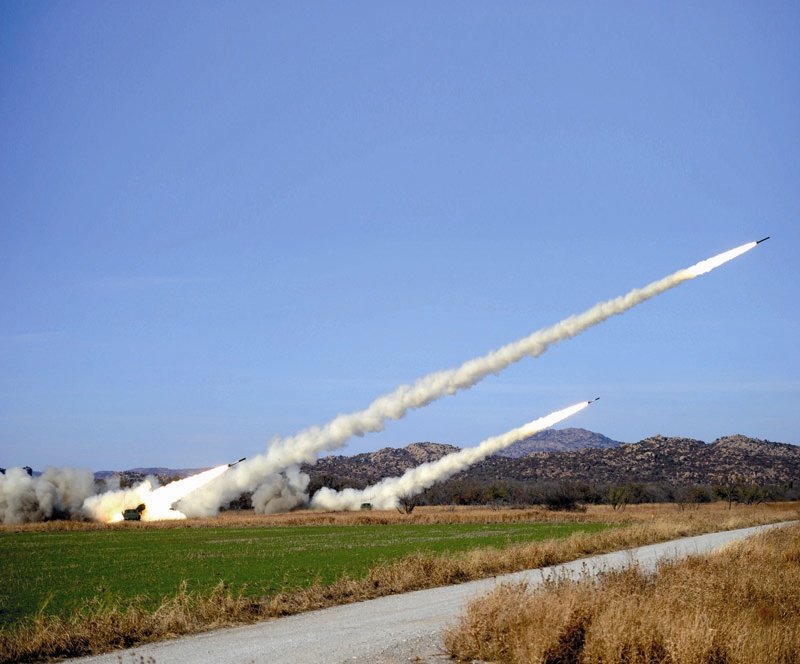HEAVY-HITTING ARTILLERY
STORY // Ong Hong Tat
PHOTO // Benjamin Lee & Courtesy of SAF Film Unit
It can let loose its full load of six rockets in a blink of an eye. Meet the High Mobility Artillery Rocket System (HIMARS) of the Singapore Artillery.
They are called the "King of the Battlefield" for the simple reason that any hint of an impending bombardment sends ground troops scurrying for available cover. When it comes to raw firepower, the Artillery unquestionably commands the most.
Continuing this fearsome reputation is the HIMARS, the latest addition to the Singapore Armed Forces' (SAF's) Artillery formation. Operated by the 23rd Battalion Singapore Artillery (23 SA), the behemoth weighs almost 16 tons when fully laden and carries six rockets.
"The HIMARS is able to displace and deploy at a much faster pace, allowing the SAF the ability to engage a target faster compared to the conventional towed-gun systems," said Lieutenant Colonel (LTC) Vincent Koh Han Seah, Commanding Officer 23 SA.
Deadly speed
Today's battlefield calls for speed, and the HIMARS has that attribute in spades. In addition to its rapid rate of fire is the fact that an experienced crew needs less than 20 seconds to get the system in a ready-to-fire mode.
Once it has dispatched its munitions, the HIMARS relies on its 330 horsepower turbo-charged diesel engine to move to its next location. With the 6.6 litre power plant, the HIMARS can attain a top speed of 94kmh.
While that might seem paltry as passenger cars can hit 120kmh easily, the HIMARS is a much heavier vehicle than your average 1.5 ton car, and most ground combat vehicles amble along at a more pedestrian pace.
The HIMARS is able to execute what commanders term a "shoot-and-scoot" operation.
To do that, the HIMARS is equipped with a Global Positioning System (GPS) which relies on a constellation of satellites orbiting the earth to determine its location.
With GPS, commanders on the ground can navigate to pre-determined safe locations as well as firing positions quickly.
Enhanced survivability
The "shoot-and-scoot" capability is not simply for show: when artillery forces fire their munitions, they expose their locations to opposing forces as it is possible to pinpoint the origin of artillery fire with trajectory mathematics.
Modern forces may also employ weapon-locating radar systems, which dramatically reduces the time needed to trace fires.
All these factors translate to a pressing need for artillery systems to be able to deploy, fire and move away rapidly to avoid counter-fire from opposing forces.
In addition, while traditional towed artillery pieces offered little or no protection to its crew, the HIMARS has an armoured cabin which offers a high level of protection.
Lethal accuracy
GPS is also present in each of the HIMARS' six rockets. This helps the rockets to make small adjustments to their flight paths, compensating for environmental factors to land within metres of their intended targets.
It is no easy feat considering that the rockets have a range of up to 70km. At such a distance, one degree off could mean missing the target by a mile.
On top of being accurate, HIMARS delivers its firepower only where it matters most. "The blast radius of the rockets is relatively small. This reduces collateral damage upon impact," explained LTC Koh.
Networked firepower
The Battlefield Management System (BMS) adds another dimension to the HIMARS' capabilities. Linked to virtually all SAF assets, the BMS enables each and every HIMARS commander to "see" the positions of both friendly and hostile forces in a graphical interface screen located within the cabin.
"This allows me to plot the best route from point to point, as well as to be aware of the areas to avoid," said 3rd Sergeant (3SG) Jonathan Tan, a HIMARS launcher commander in 23 SA.
Versatile training
Advanced technologies aside, each HIMARS is manned by a team of three, comprising a ground commander, a gunner and a driver. While the commander is responsible for key decisions such as the final order to fire, all members of the team are equally well trained in each other's roles.
"Effectively, there are no skills or knowledge exclusive to any one crew member. Any one of us may be called to assume other roles when the need arises," said 3SG Tan.
Working as a tightly-knit team, the driver is responsible for getting the vehicle from point to point quickly and safely, while the gunner operates the Universal Gunners Display unit to key in fire mission parameters. "We work as a team and decisions are taken only after I have consulted my crew," explained 3SG Tan.
The HIMARS was delivered to the SAF in July 2010. Subsequently, about 170 personnel from 23 SA conducted the inaugural battery live-firing exercise, codenamed Daring Warrior, at Fort Sill, Oklahoma in the United States from 10 to 21 Nov 2010.
| Tech Specs |
| Engine 6.6litre turbo-charged diesel (delivers 330hp) |
| Length 6.94m |
| Height 3.18m (in operation) 2.68m (stowed) |
| Width 2.44m |
| Weight 13,592kg(without rockets) 15,873kg (with rockets) |
| Mobility Fording 0.70m Trench 0.76m |
| Max Speed 94kmh |










